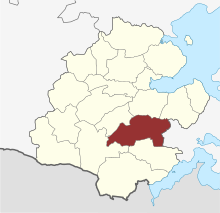Kliplev Sogn
| Kliplev Sogn | ||||
|
||||
| Basic data | ||||
|---|---|---|---|---|
| State : |
|
|||
| Region : | Syddanmark | |||
|
Municipality (since 2007) : |
Aabenraa | |||
| Coordinates : | 54 ° 56 ' N , 9 ° 24' E | |||
|
Population : (2020) |
2,183 | |||
| Postal code : | 6200 | |||
 Location of the Kliplev Sogn in the Aabenraa municipality |
||||
Kliplev Sogn (German Klipleff ) is a parish in North Schleswig in southern Denmark . Until 1970 it belonged to Harde Lundtoft Herred in Aabenraa-Sønderborg Amt , then to Lundtoft Kommune in Sønderjyllands Amt . Since 2007 Kliplev Sogn belongs to the Aabenraa municipality , Region Syddanmark . 2183 inhabitants live in the parish, 1202 of them in Kliplev , fewer than 200 in Bjerndrup and 318 in Søgård (as of January 1, 2020).
The center of Kliplev Sogn is Kliplev's Gothic Church of the Redeemer ( Vor Frelser ) from 1450. The former pilgrimage church impresses with baroque furnishings, numerous chapels and a roof turret that can be seen from afar.
Municipal area
The parish, which extends in east-west direction, borders in the north on Uge Sogn (Ger. Uk ), Ensted Sogn (Ger. Enstedt ) and Felsted Sogn (Ger. Feldstedt ), in the east on Kværs Sogn (Ger. Quars ), in the south at Holbøl Sogn (dt. Holebüll ) and in the south-west at Tinglev Sogn (dt. Tingleff ).
history
In the Middle Ages , Kliplev belonged to the Lundtoft harde , which was named after Kliplev in King Valdemars II's earth book of 1231. Kliplev's church was an important place of pilgrimage not far from the ox path . The legal and administrative district was administered from the lordly castle Søgaard (Seegard). In the 14th century, however, this fell into noble hands and could no longer be redeemed by the duke or king . From then on, Søgaard was the largest aristocratic estate in the Duchy of Schleswig , and several of its owners served as royal governors in Schleswig and Holstein . The entire parish of Kliplev was under the estate. In 1722 the big business was over when Søgaard went bankrupt. In the end, however, the lords' headquarters were no longer Søgaard, but Gråsten (Eng. Gravenstein ) in the eastern part of the complex. The individual main and Meierhöfe were sold to various nobles until 1725, including Gråsten to the Duke of Augustenborg . From then on Søgaard was only a relatively small estate. In the parish of Kliplev, Årtoft (dt. Ahretoft ) also made its own business as its own.
When the noble estates lost their administrative independence in 1853 and were from then on only rural communities, the old Lundtoftharde was restored. From then on, Kliplev was only subject to one sovereign jurisdiction, which in turn was subordinate to the Aabenraa office.
The war between Denmark and the great German powers led to the annexation of the Duchy of Schleswig to Prussia in 1867 . The four rural communities came to the new Aabenraa district , which was almost identical to the old office.
In the referendum in 1920 there was a Danish majority in Kliplev. From then on, the parish of Kliplev formed a unified municipality in the newly structured Danish Aabenraa office .
In 1970 Kliplev was merged with Felsted and Varnæs to form the new municipality of Lundtoft. The name alludes to the old Hardes center in the parish of Kliplev, which however did not gain in importance. The town hall was moved to Felsted. In 2007, Kliplev became part of the large municipality of Aabenraa, which, however, has greatly changed its size and is equivalent to the old Aabenraa office.
Attractions
The Seegaarder See ( Søgaard Sø ) has the reputation of being the most beautiful lake in North Schleswig . Most of it is accessible, but the north-eastern bank is restricted area from Søgaard barracks.
Individual evidence
- ↑ a b Statistics Banks -> Befolkning og valg -> KM1: Befolkningen January 1st, April 1st, July 1st and October 1st, so og folkekirkemedlemsskab (Danish)
- ↑ Statistics banks -> Befolkning og valg -> BY1: Folketal January 1st efter byområde, alder og køn (Danish)


